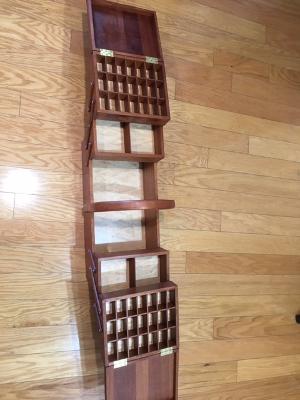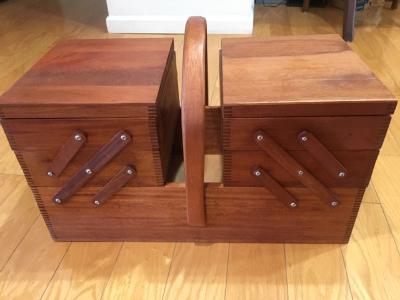Newsletter September 2020
President's Message
Fellow woodworkers,
The balance between handwork and machines
Recently a member asked why I have not written about making things by hand compared with making them by machine.
I was hesitant as I was not sure if the answer was so obviously it did not warrant discussion or so complex it would need full dissertation.
(I decided that in this context machines and power tools are the same, ie:, they are not handwork).
Machines have been used in woodworking for a very long time.
(I decided that in this context machines and power tools are the same, ie:, they are not handwork).
Machines have been used in woodworking for a very long time.
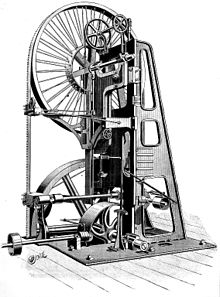
Early bandsaw

Salamander sawmill Netherlands
A brief history of woodworking machines:
The ancient Egyptians are credited for developing the first ever power tool: a hand -powered lathe.
End of the 16th century: Cornelis Corneliszoon van Uitgeest invented the world's first wind powered sawmill Salamander.
1623: 1623: the first water operated sawmill in the United States opened on the Piscataqua River near York, Maine
1777: Endlishman Samuel Miller invented the first spinning (circular) saw blade that was in used early sawmills . It took more than 150 years and the development of electricity as a practical power source before someone would come up with the idea for a portable saw.
1809: William Newberry received a British patent for the idea of a bandsaw but they remained impractical because of the inability to produce accurate and durable wielded blades. The constant flexing of the blade over the wheels caused either the material or the joint to fail.
1846: Frenchwoman Anne Paulin Crepin patented a welding technique overcoming this problem and soon afterward sold the manufacturer rights to the A. Perin & Company of Paris. Combining this method with new steel alloys and advanced tempering techniques allowed Perin to create the first modern bandsaw blade.
1836: the first American bandsaw patent was granted to Benjamin Barker of Ellsworth, Maine and the first factory produced and commercially available bandsaw in the U.S. was by a design of Paul Prybil.
1922: Raymond Dewalt devised the first radial arm saw using a circular saw blade.
Today most woodworkers use a combination of power and hand tools.
One of the most used of power machines today is planner/thicknesser. I think, unlike the mechanized saws, mechanized planers came much later so it stayed a hand operation. The result was (unlike today) flat, planed surfaces were not considered essential for all applications; an axe and adze cut surface worked well enough. No need to square rafters since only one side needed a flat suface to fasten laths to, the outside of back panels of most cabinets did not have to be planed, doors could be crudely-cut planks.
I would never dream of trying to flatten new boards for a bench-top by hand but I am sure my bench-tops are nowhere near as flat as those created by the Unplugged Woodworkers (You can find a group of them on YouTube)
Sometimes it is faster to hand cut dovetails rather than setting up a jig, but when you have a project with many dovetail joints a jig and routing machine will be faster.
I remember at a workshop on how to hand-cut Chinese joints, the question of hand-tools versus machine tools came up. The instructor's reply was even though master carpenters of old did all their work with hand-tools he thought today they would use power tools. Just because we have the skills to make beautiful hand-cut joints it is not always efficient to spend so much time hand cutting.
Reality check:
$$500: You can purchase a perfect looking table from IKEA
It will look perfect with every edge straight and every joint perfect with a uniform finish that involves 10 – 20 process, the wood stripped of any natural imperfections.
$2000 You can have a similar table custom made by a craftsman using power & hand-tools.
It will have a handmade look with some "imperfections"
$10,000+: You can also buy a beautiful table made mostly by hand with all of the joints perfectly cut.
The craftsman will have spent months working on it justifying its high price.
The balance between handwork and machines is the balance between what you enjoy doing and what you need to earn.
Enjoy your woodwork Frank (Contact at: Frankramsay8@aol.com)
Top
September 2020 BAWA Zoom Meeting
Announcements:
Jon announced that next month's speaker will be Dennis Hays from the LA area who runs classes for the Maloof Foundation
Top
The Zoom meeting was called to order by President Frank Ramsay at 6:05 PM.
Post meeting comment by Lloyd: During the meeting, there were some questions about methods of installing threaded brass inserts.

The washer provides a reference to seat the insert square
The nut behind the washer allows a lot of torque to be applied and still provide a way to remove the screw.

The washer provides a reference to seat the insert square The nut behind the washer allows a lot of torque to be applied and still provide a way to remove the screw.
Featured Chance Coalter, from San Diego
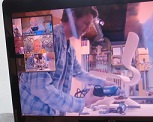
Screen shot
Speaker-Chance Coalter, from San Diego, has worked in woodshops since childhood. He attended San Diego State and now teaches at Palomar College.
Up to now he has made very intricate pieces, but is now transitioning to more production-oriented objects.
Chance's chair
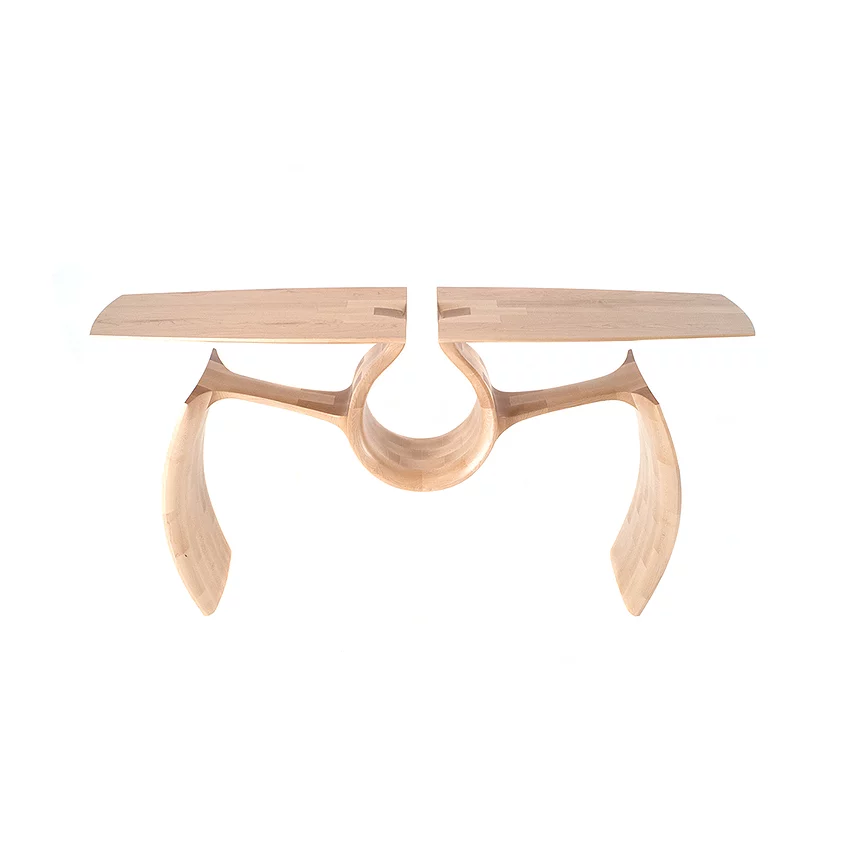
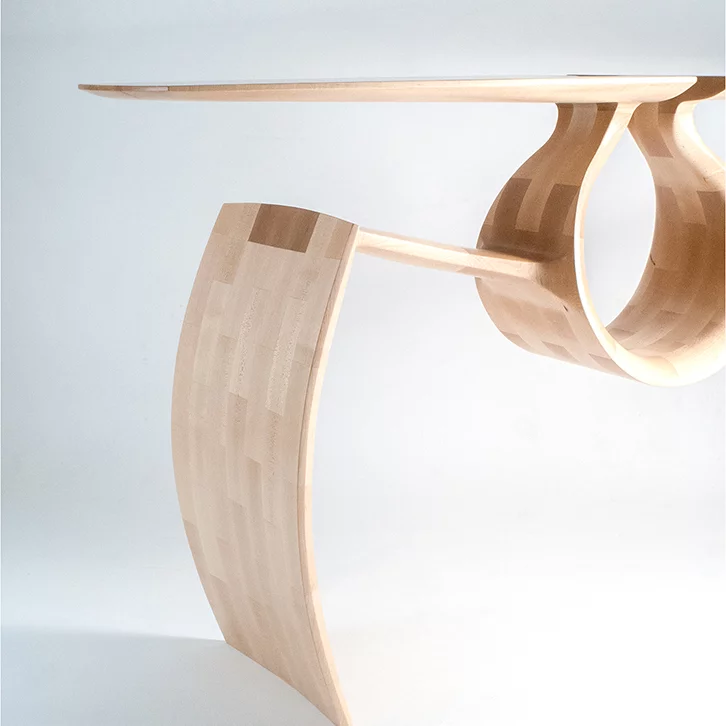
Chance's small table
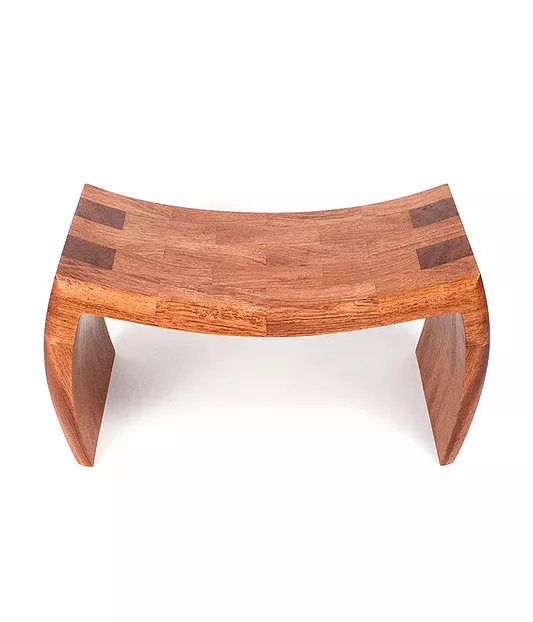
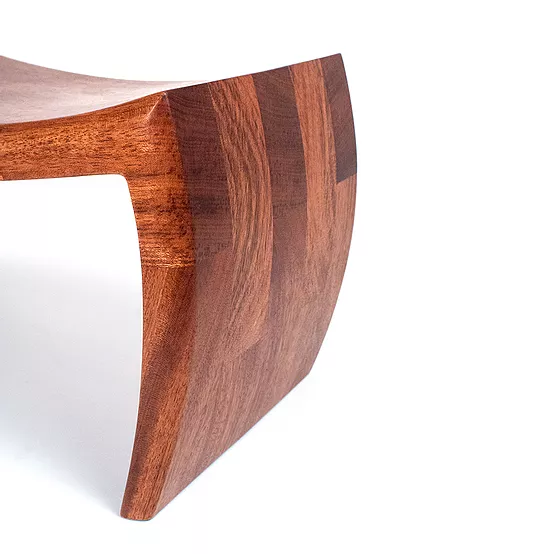
The projects he described today are a stack laminated chair and stool, which are made by gluing small pieces of wood together that are then carved to final shape. He starts the project with a sketch and then makes models with poplar or modelling clay. He lays out the project on templates and decides where each small piece will go to maximize the straight grain. The layout consists of A and B layers which are laid out so the joints do not overlap and are then glued together in alternating layers. The pieces are cut on the bandsaw.
The chair he showed had 256 pieces in it. After glue-up he uses a chainsaw, Sawzall, edge grinder using the Holey Galahad cutter, and sander to get the final smooth profile. He prefers the Galahad over the Arbortech because it does not grab the work. He uses a flat abrasive pad as well. He prefers to use maple, which is less porous than ash. Porosity can be a problem when the humidity changes quickly causing cracking. To get the final surface he uses a rasp, a spokeshave, and does hand sanding. To look for bumps he bends a thin, flexible hacksaw blade over the surface to pick out high spots. He also uses thick and thin card scrapers as well as a sanding block made from 3/4 in. MDF with a vertical piece glued on for reinforcement. He uses Scotch tape to "clamp" pieces together while the glue sets. Titebond III is his most favored glue, but he has also used epoxy and powder formaldehyde glue. Hide glue does not work well. He first applies diluted Titebond to the joint so it penetrates the end grain and then the full-strength glue.
Top
Virtual Shop Tour
Dust Collection Systems
John Wilson
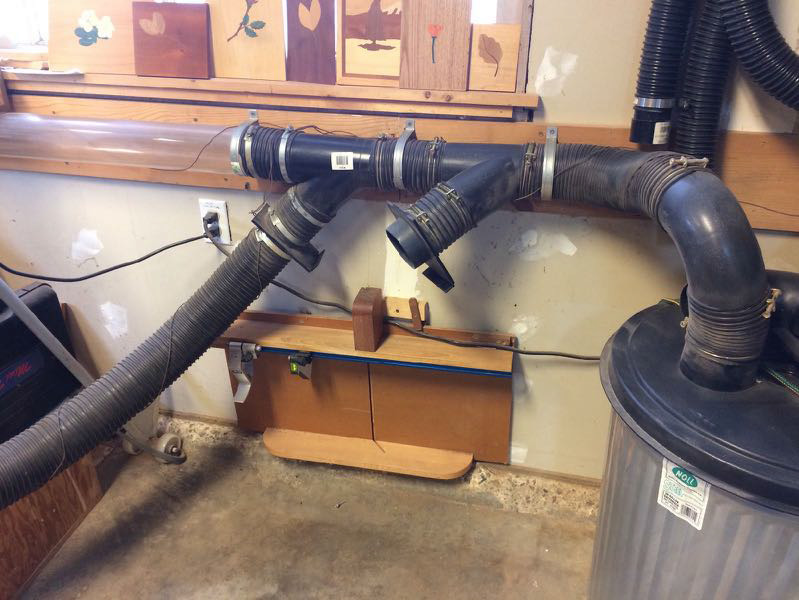
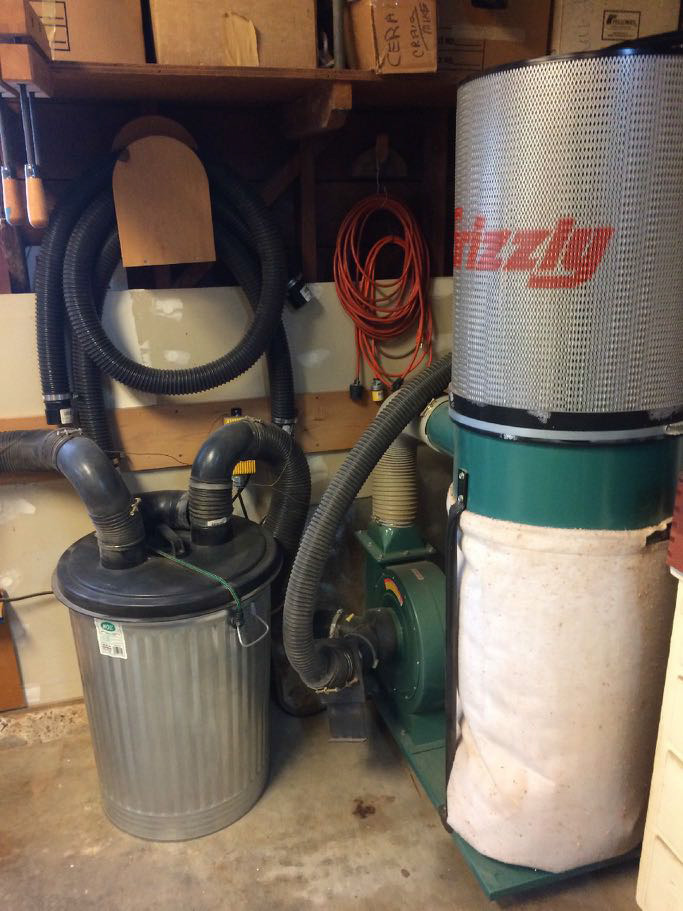
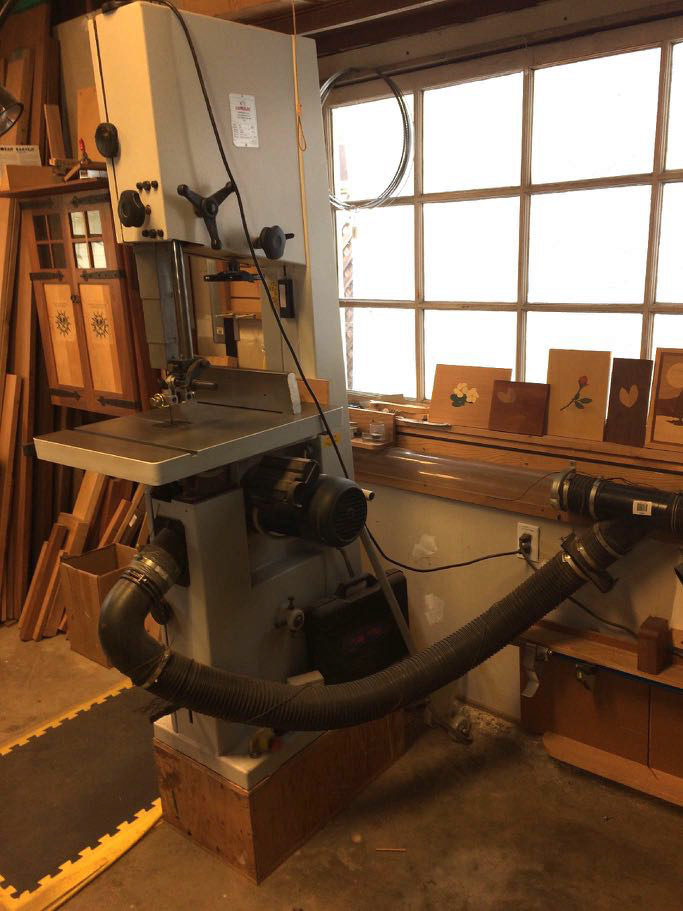
John has a Grizzly 1.5 HP Dust Collector
1 micron filtration
2 stage Cyclone Separation
4" plastic pipe (properly grounded)
manual plastic blast gates.
Ken Napior
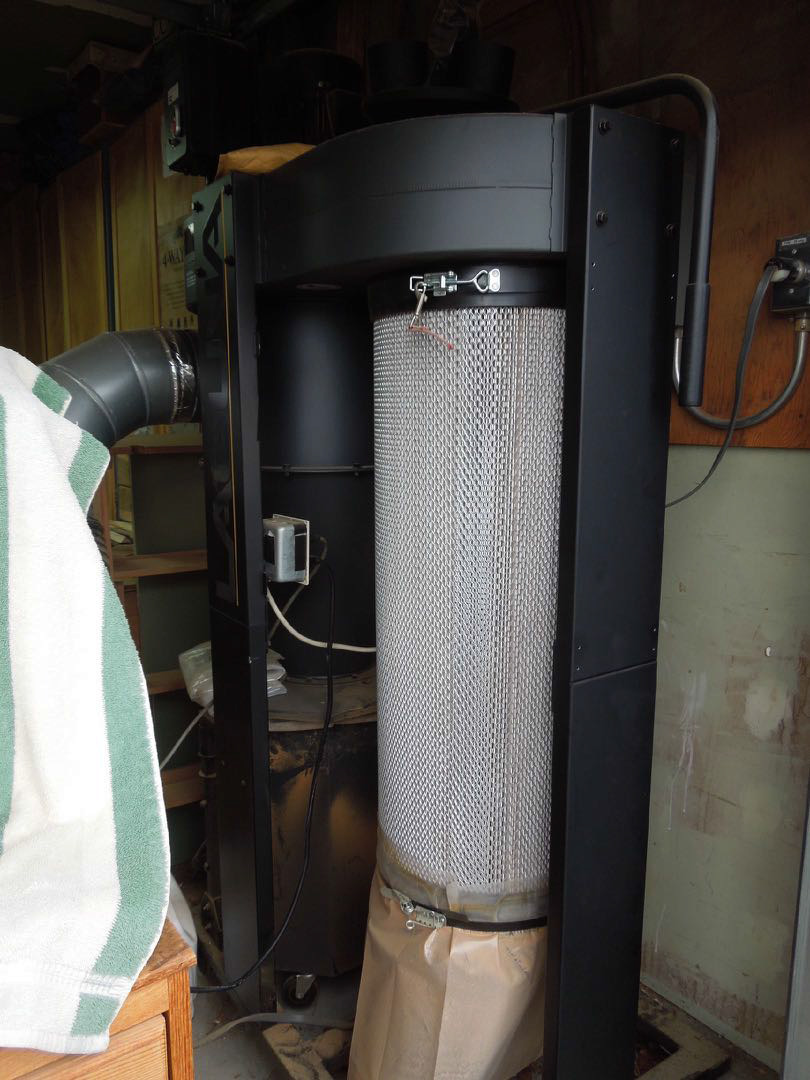
Laguna 3 HP dust collector
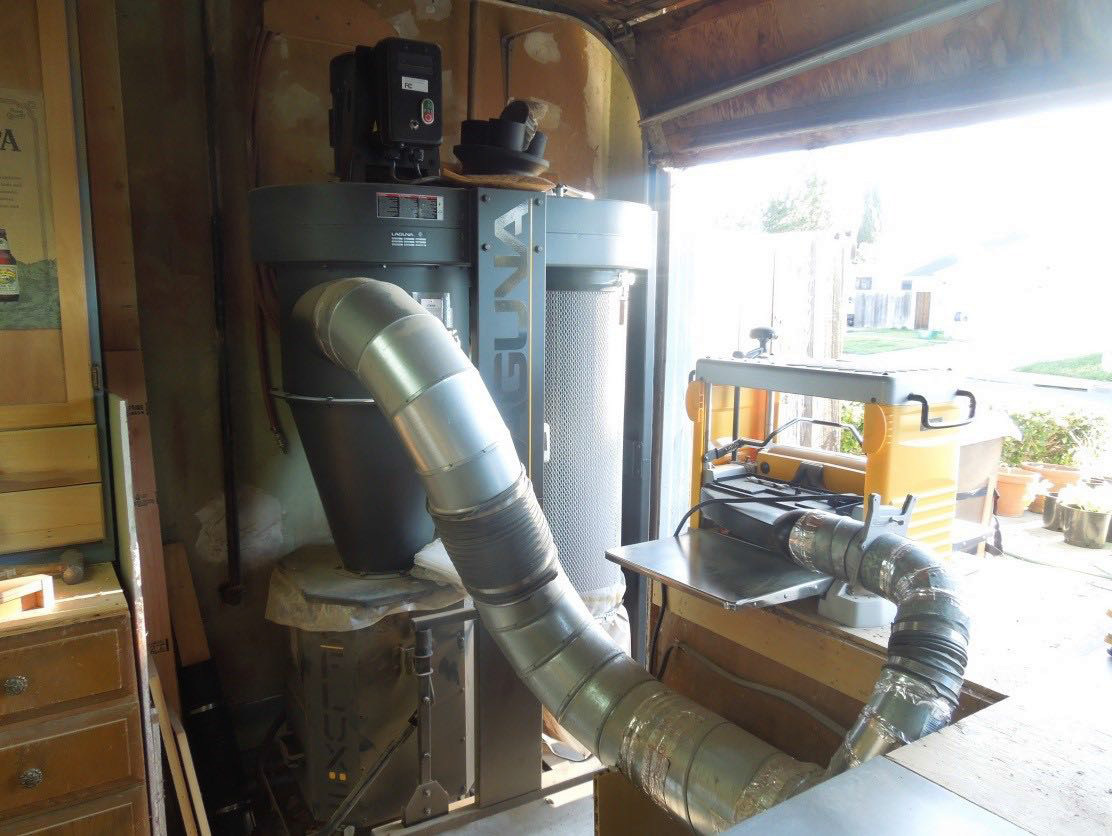
Ducting covers his entire shop
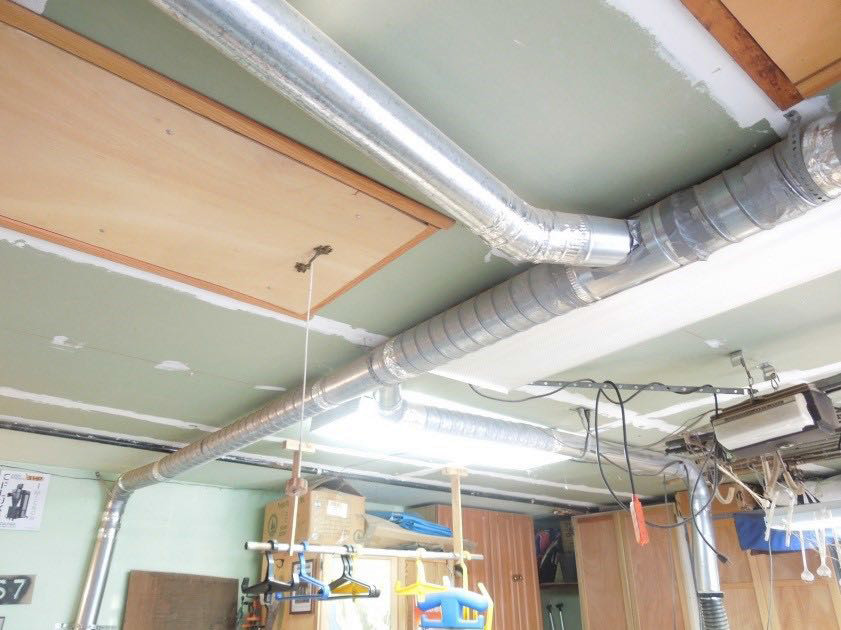
The duct work in the ceiling and around the shop
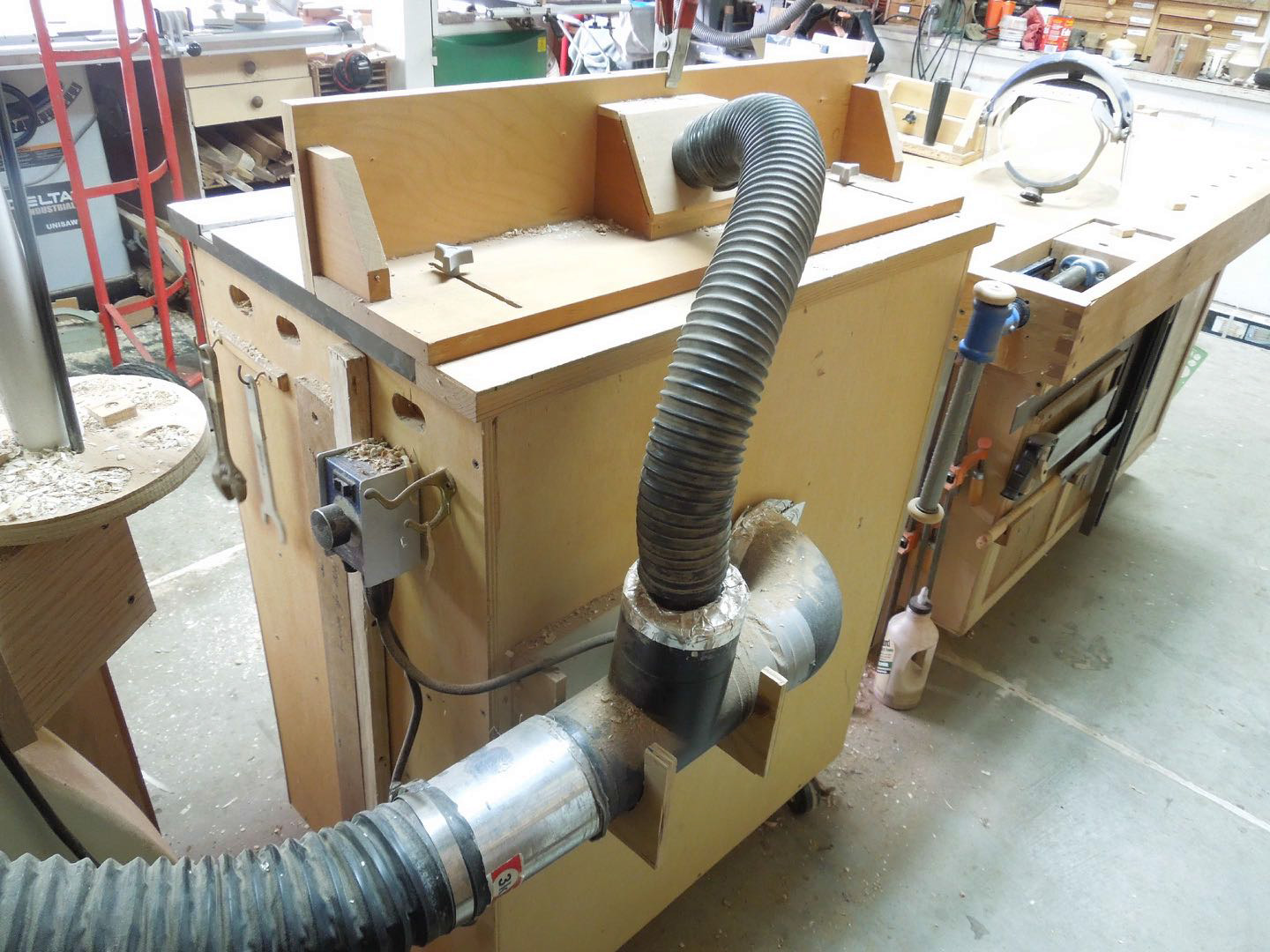
The duct work at the router table

Laguna 3 HP dust collector

Ducting covers his entire shop

The duct work in the ceiling and around the shop

The duct work at the router table
Lloyd Worthington-Levy
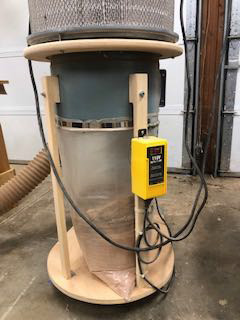
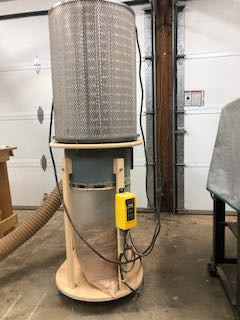
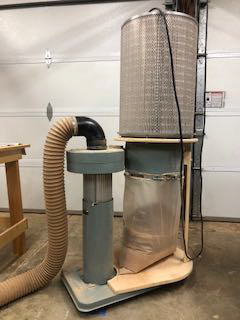
I use a modified Delta dust collector
which is moved from table saw to planer when needed.
Modifications include replacing the original cloth filter bag with
a HEPA filter and supports to handle added weight.
The dust collector has an add-on remote control
so that it can be turned on easily.
Burt Rosenzweig
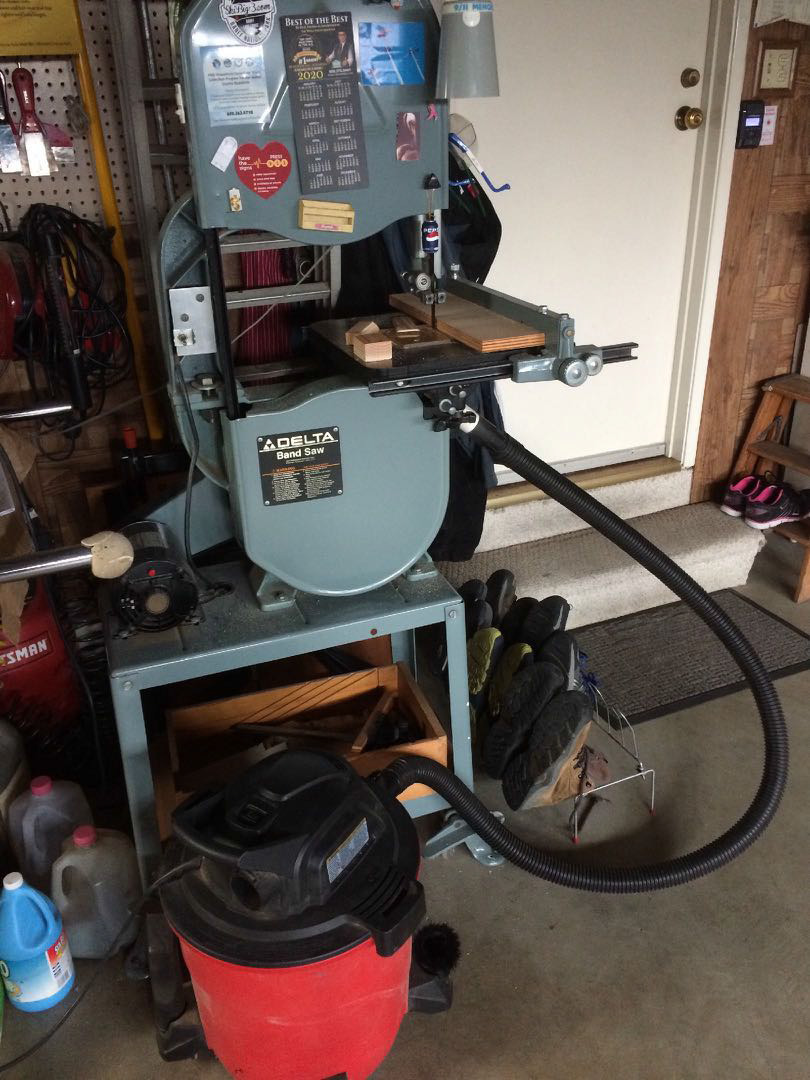
Burt has 2 Shopvacs in his garage.
Here is my very sophisticated dust collection system.
I did have to machine a
custom adapter to get
the vacuum hose to fit the bandsaw dust collection port.
I have a similar setup for my stationary belt/disc sander.
I have two Craftsman shop
vacuums in my garage.
Bill Henzel
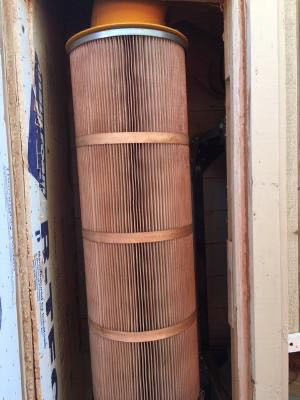
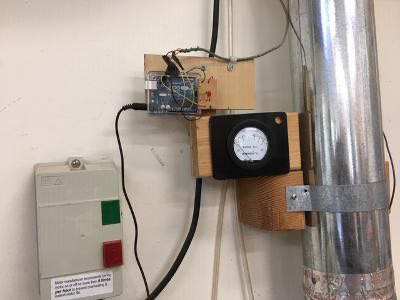
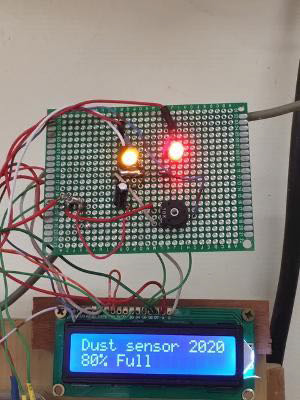
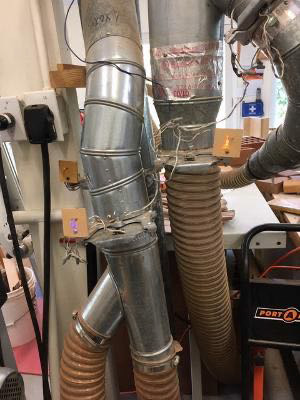
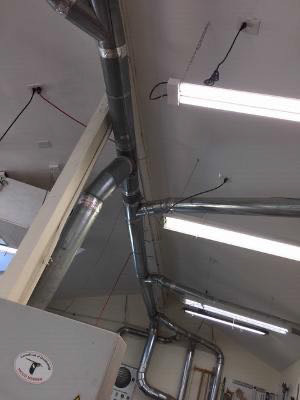
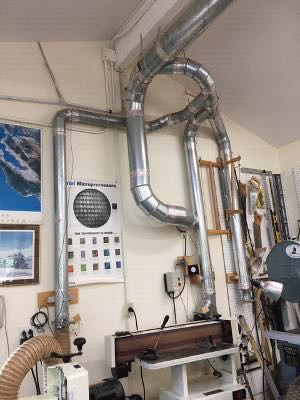
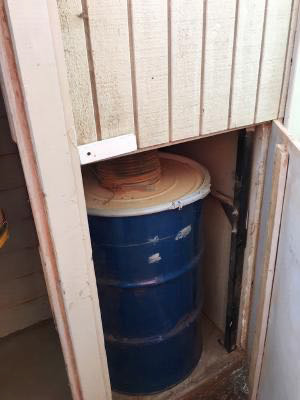
Bill has a 2 hp Oneida Dust Gorilla
with a home built optical sensor that lets him know when the bag is full.
His ductwork covers the entire shop.
Bruce Powell
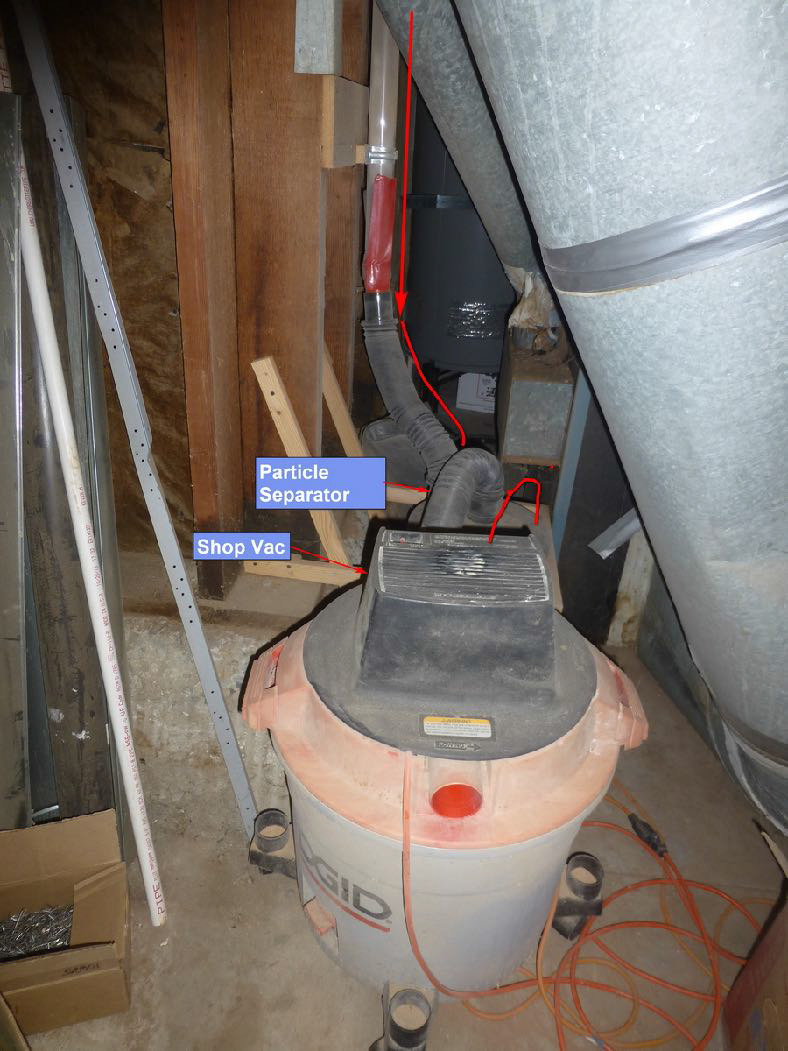
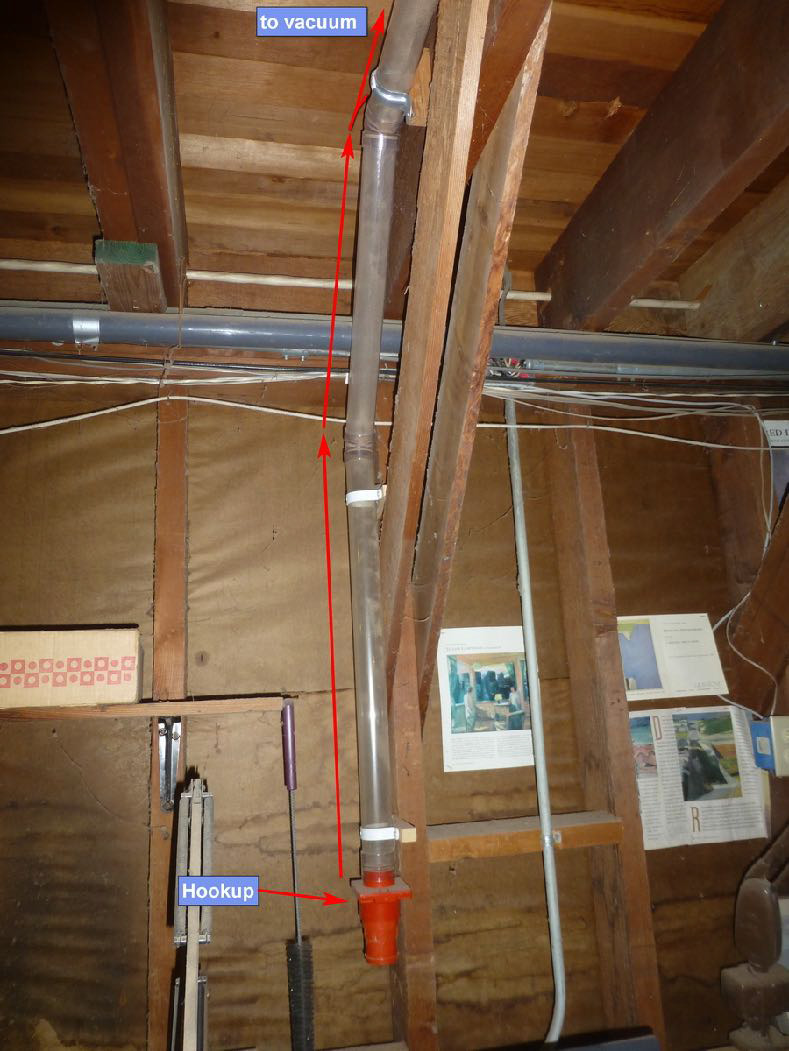
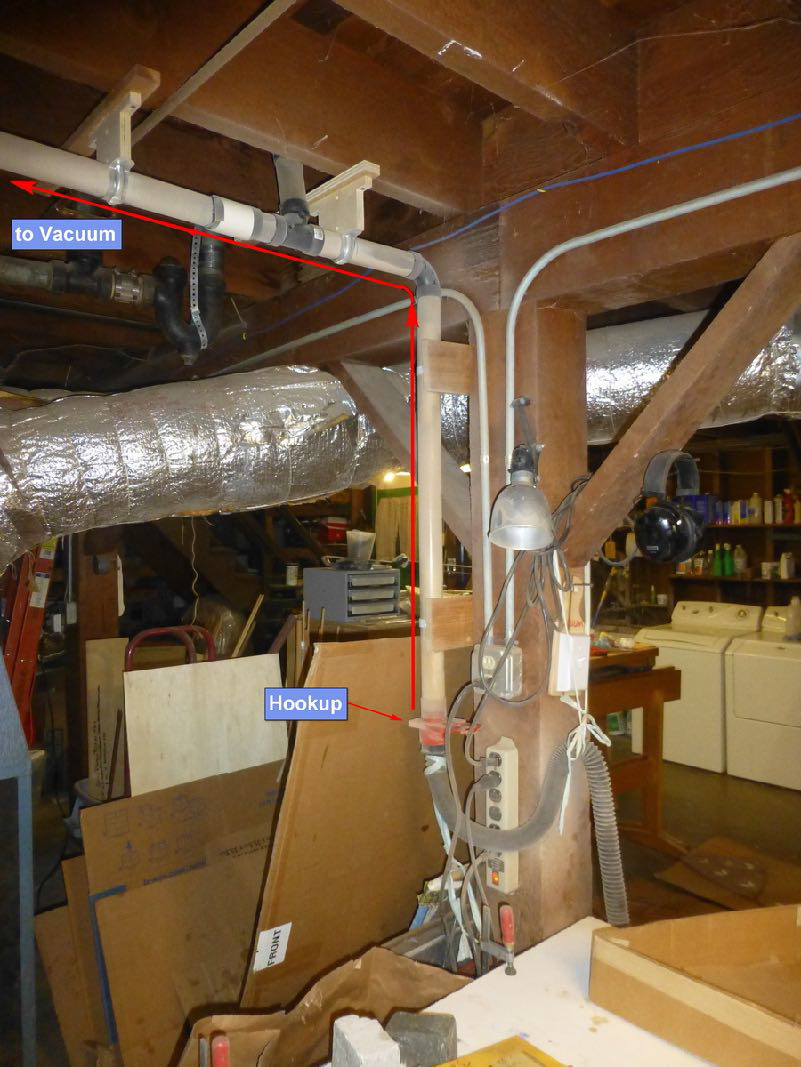
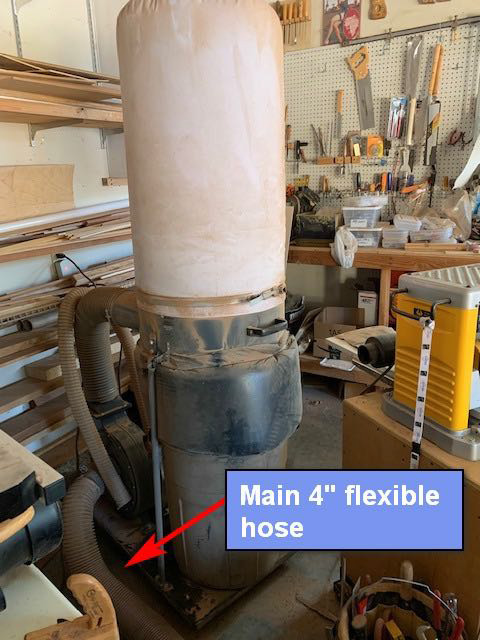
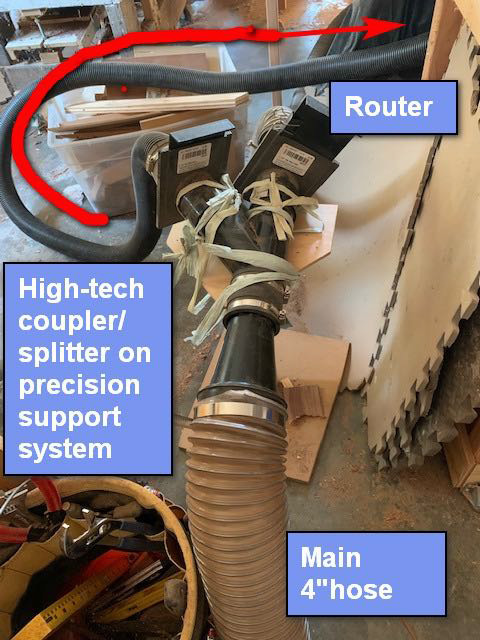
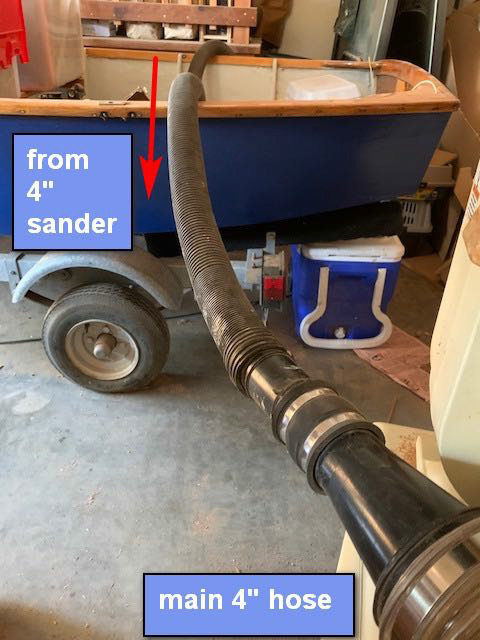
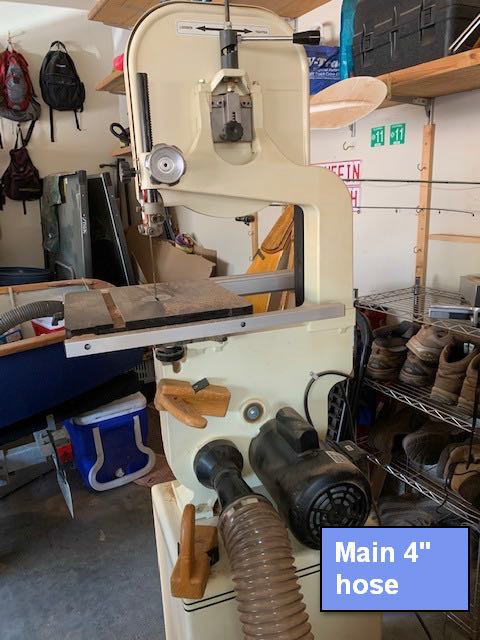
Bruce has a Shopvac with a particle separator in SF with 2.5-inch ductwork covering the shop. In Groveland his ductwork is 4-inch hose split into a wye.
Harold Patterson
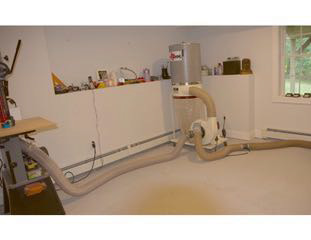
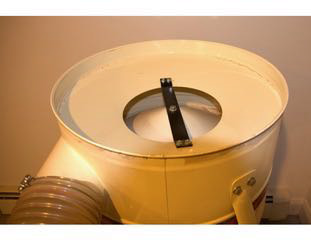
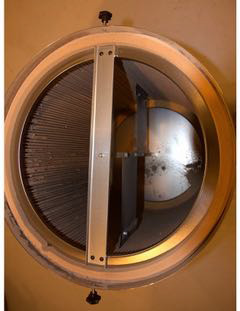
Harold has a Jet 1100CK hooked up to his bandsaw and jointer/planer combo. He has a remote receiver transmitter on/off switch and a vortex particle separator.
Tom Gaston
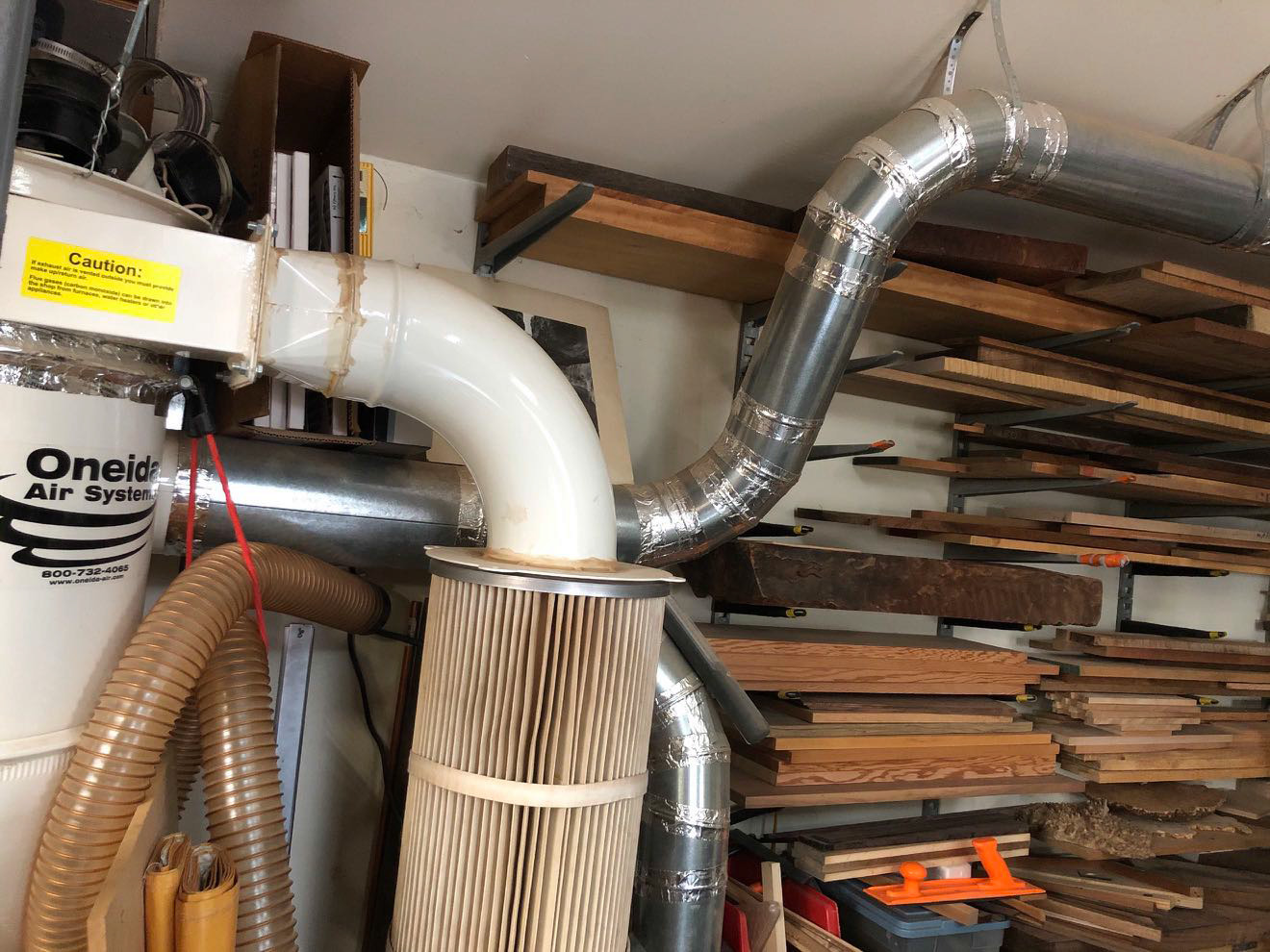
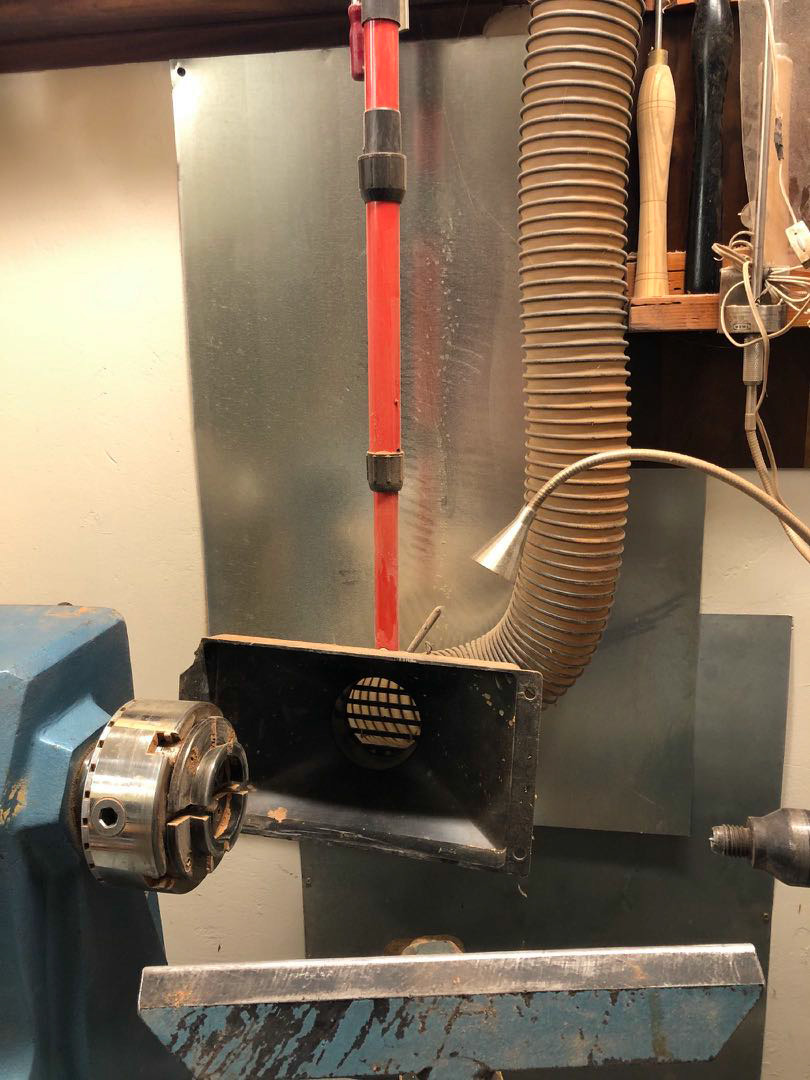
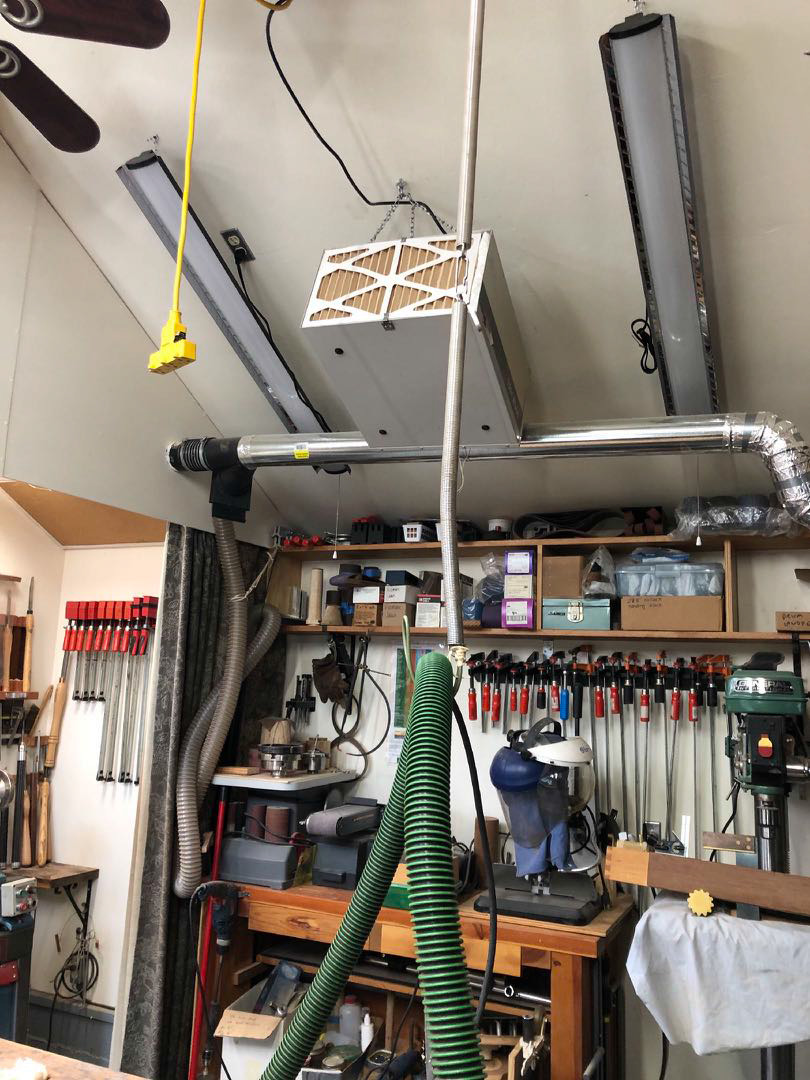
Tom has a 2 HP Oneida with cyclone separator.
He uses metal ducting which is smooth and grounded.
He uses a Shopvac
for his hand sander.
His lathe and band saw generate the finest dust.
Dennis Yamamoto
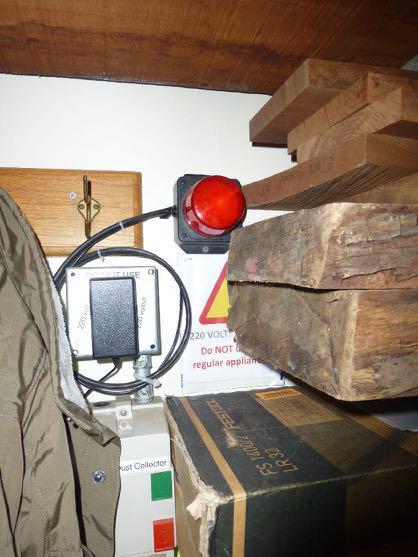
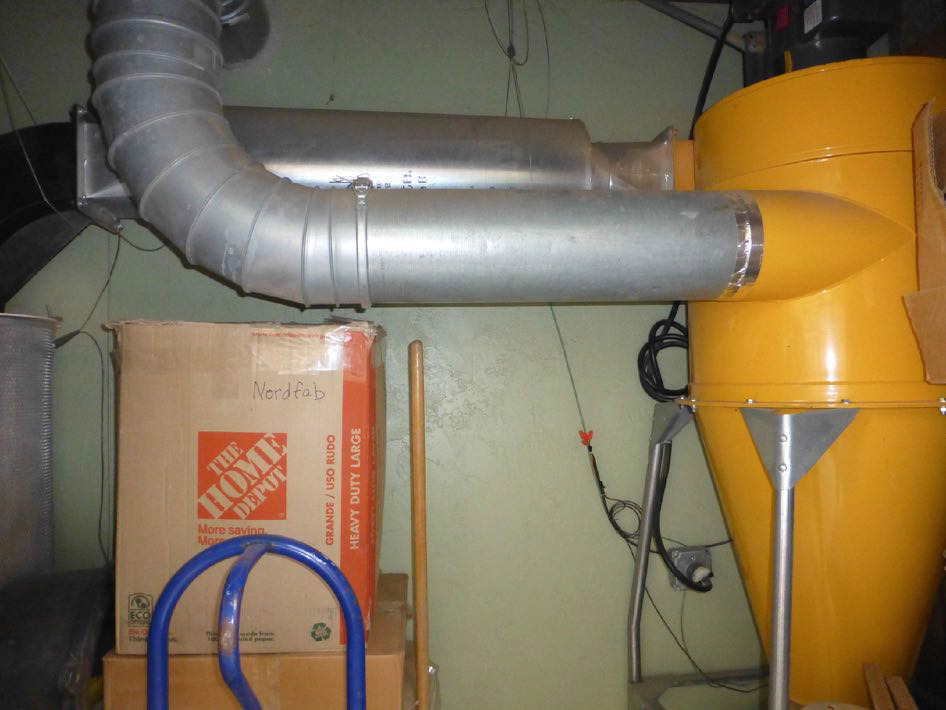
Dennis has a 5 hp Oneida cyclone which he vents outside through a filter.
For ductwork, he uses Nordfab
reconfigurable pipe
hung with Gripple hangers.
Jay Perrine
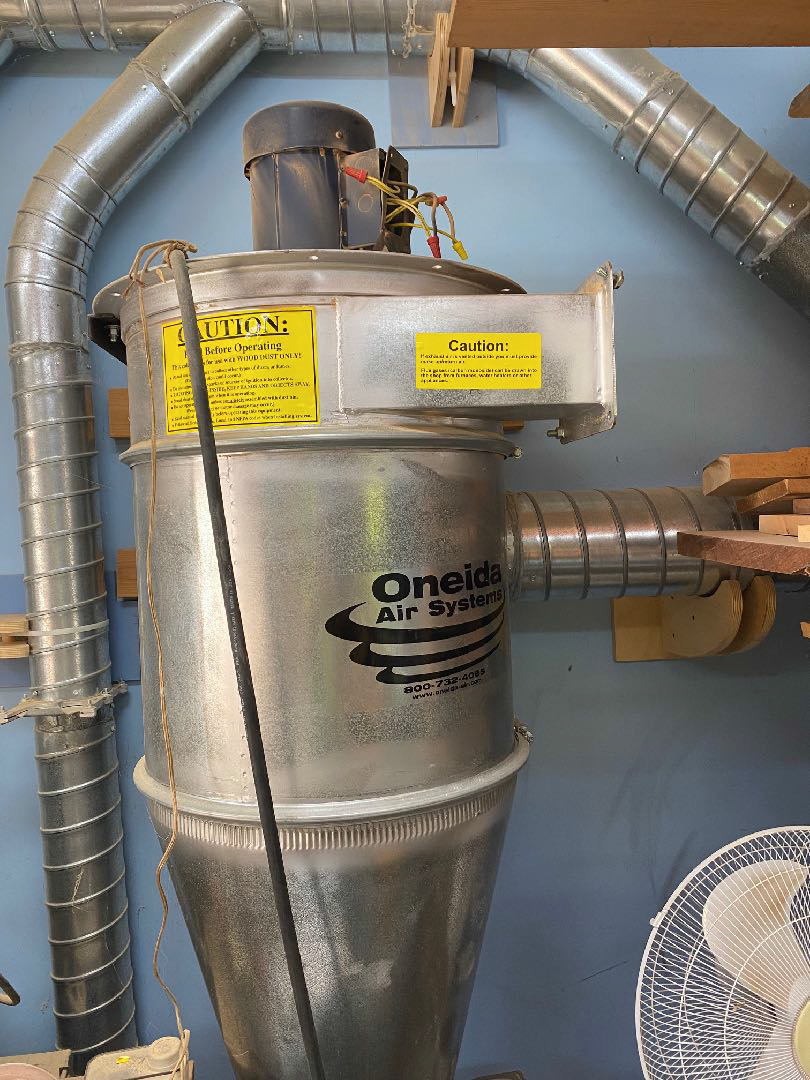
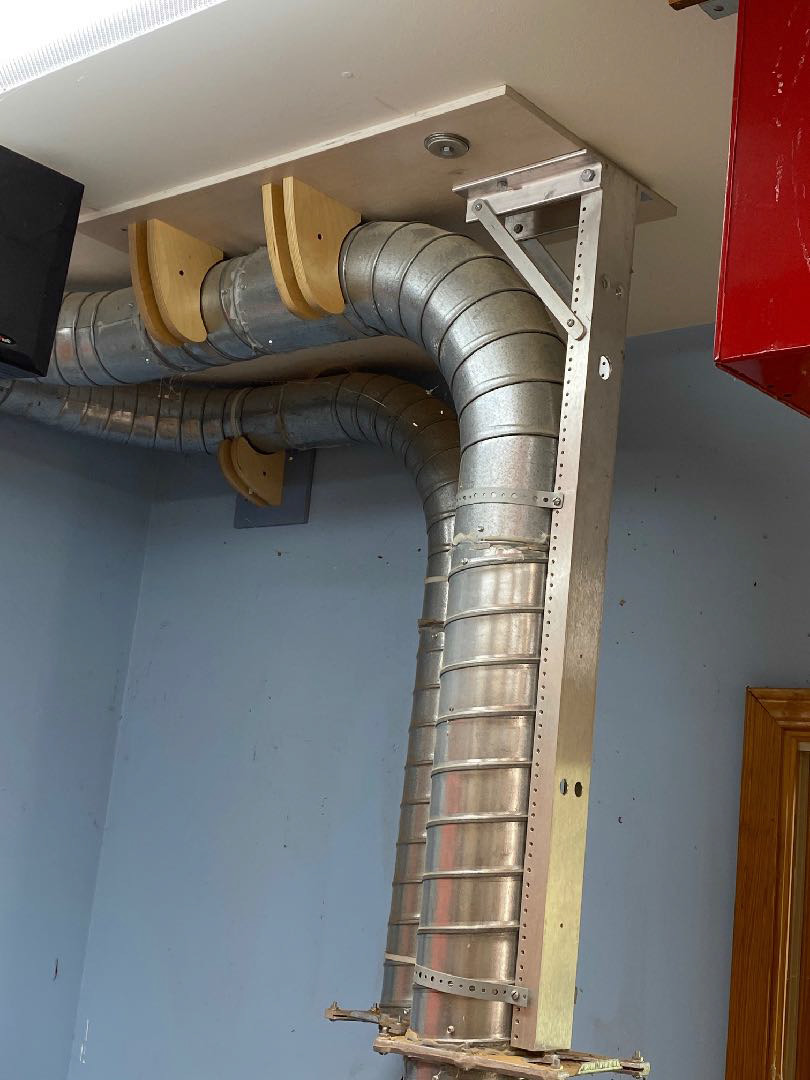
Jay has a 2 hp Oneida system. He built custom wooden brackets to hold his ductwork.
Jamie Buxton
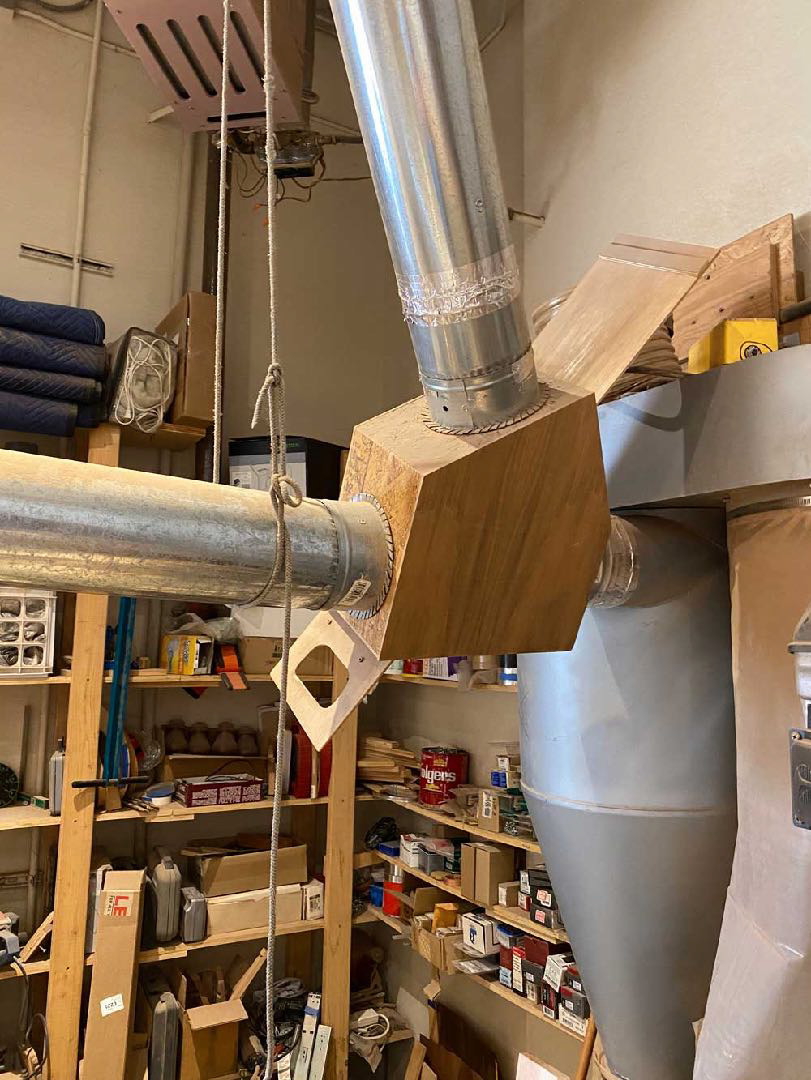
Jamie has a cyclone with a small footprint which connects through
his own designed wooden splitter box to
6-inch ductwork covering his entire shop.
His dust filter is a clear plastic bag which encloses a filter in
which the dust collects on the outside of the filter.
Next month's shop tour will be on hand planes
Top
Show and Tell
Lloyd Worthington-Levy
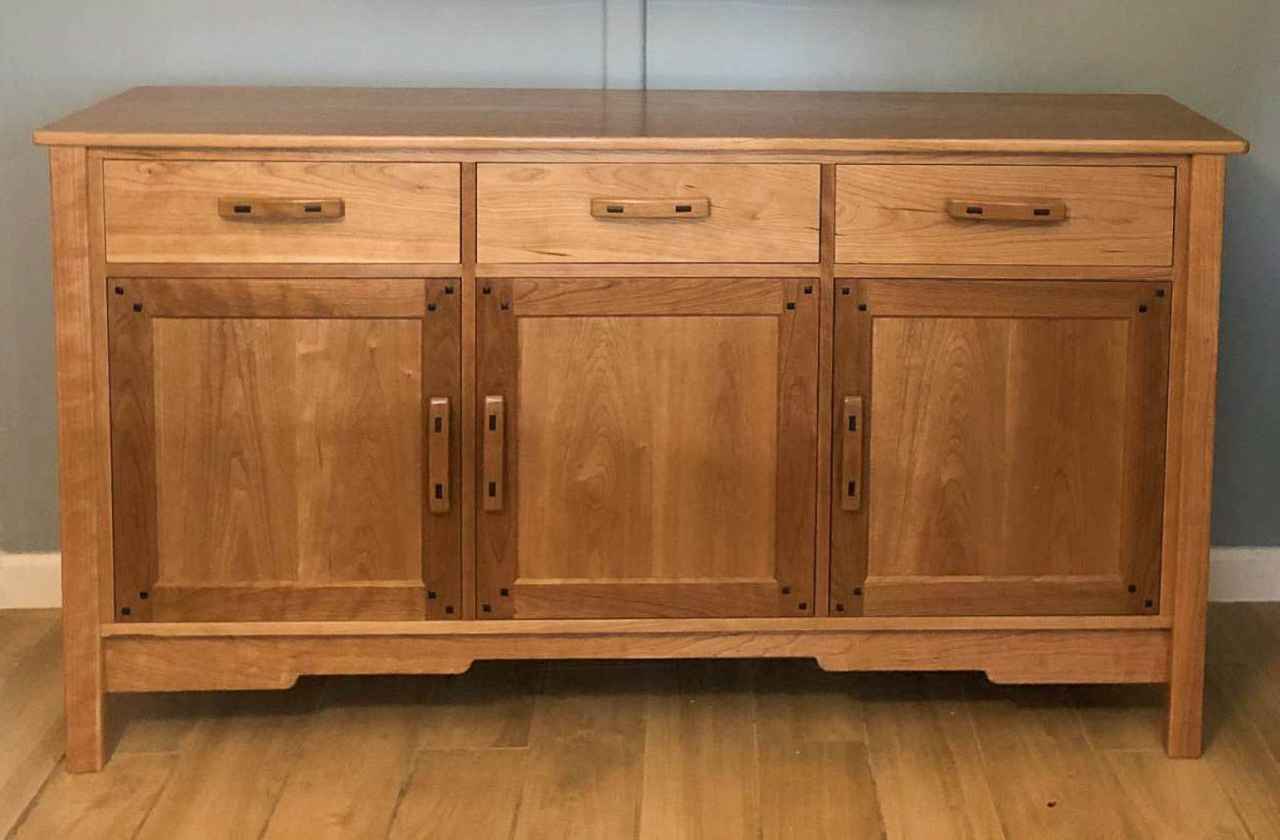
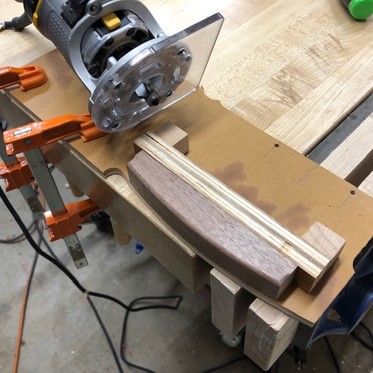
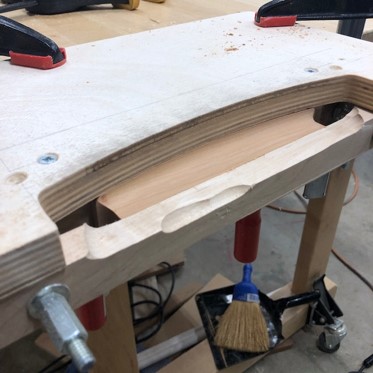
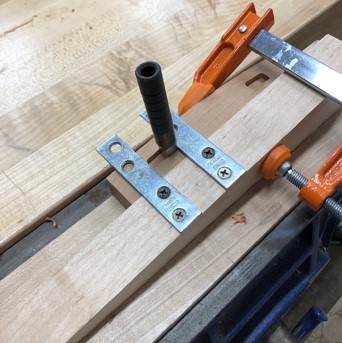
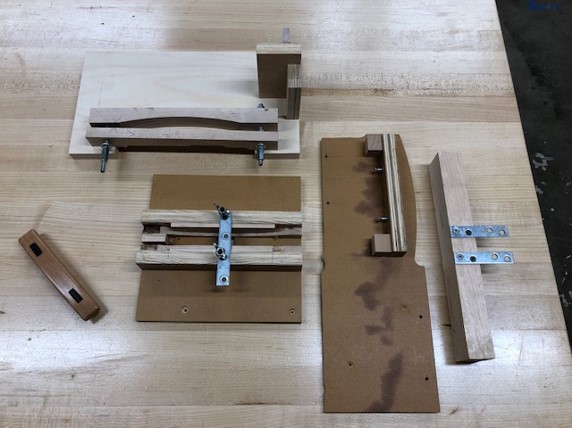
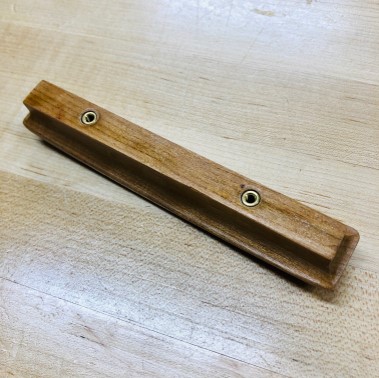
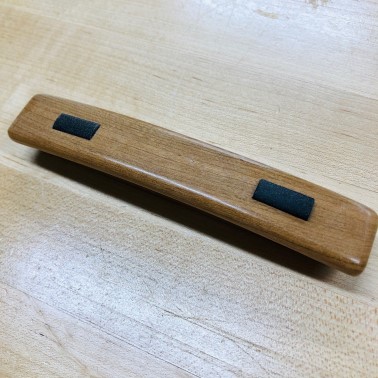
Lloyd showed a Greene and Greene inspired sideboard
with design features inspired by books by Darrell Peart. It is made of cherry
with wooden drawer pulls.
It is finished with General Finishes water-based polyurethane and wax.
Ed Schoenstein
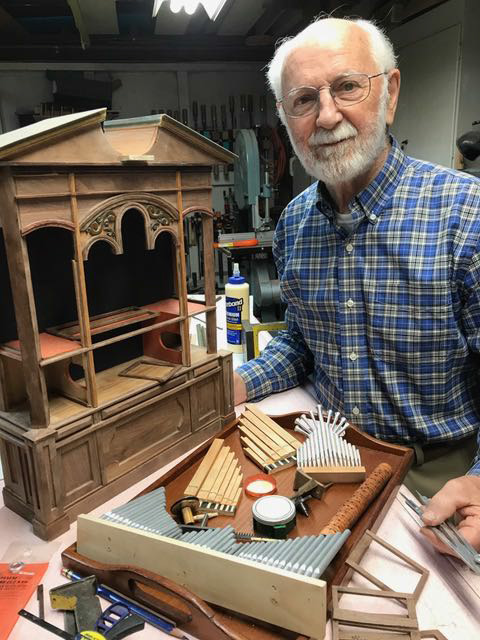
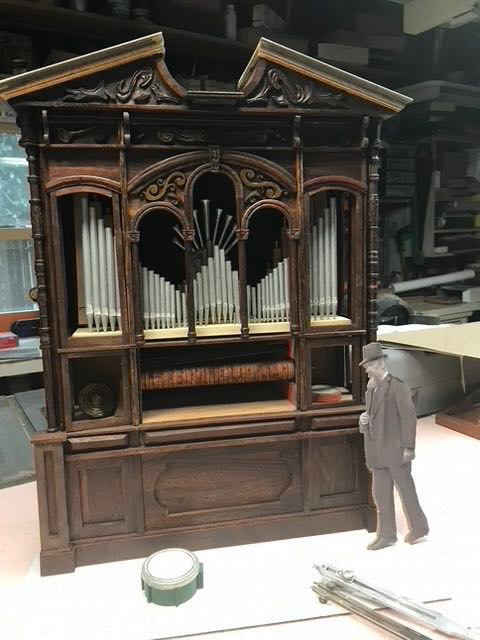
Ed made a model of an 1890's era jukebox of which his grandfather had made
6 full size versions that were installed in San Francisco.
Harry Filer
Harry showed models of race cars he has built for the Toy Workshop.
They are painted in different colors.
He also showed a box made of Japanese maple from his yard.
Tom Gaston
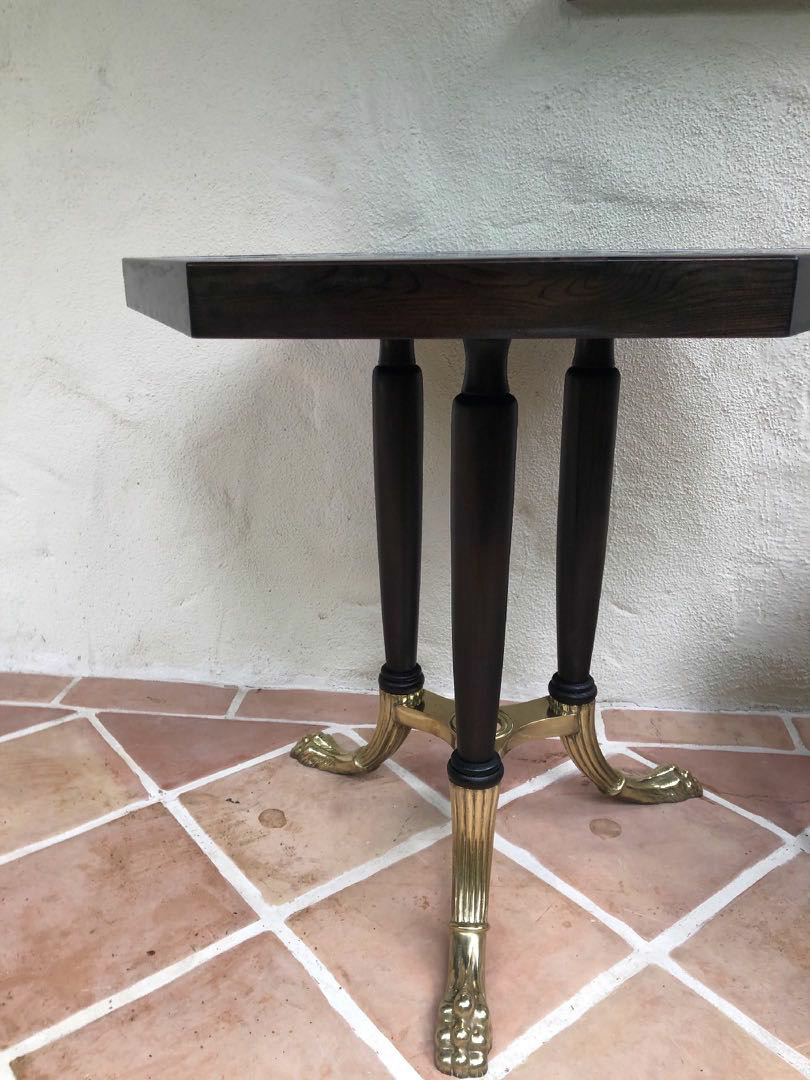
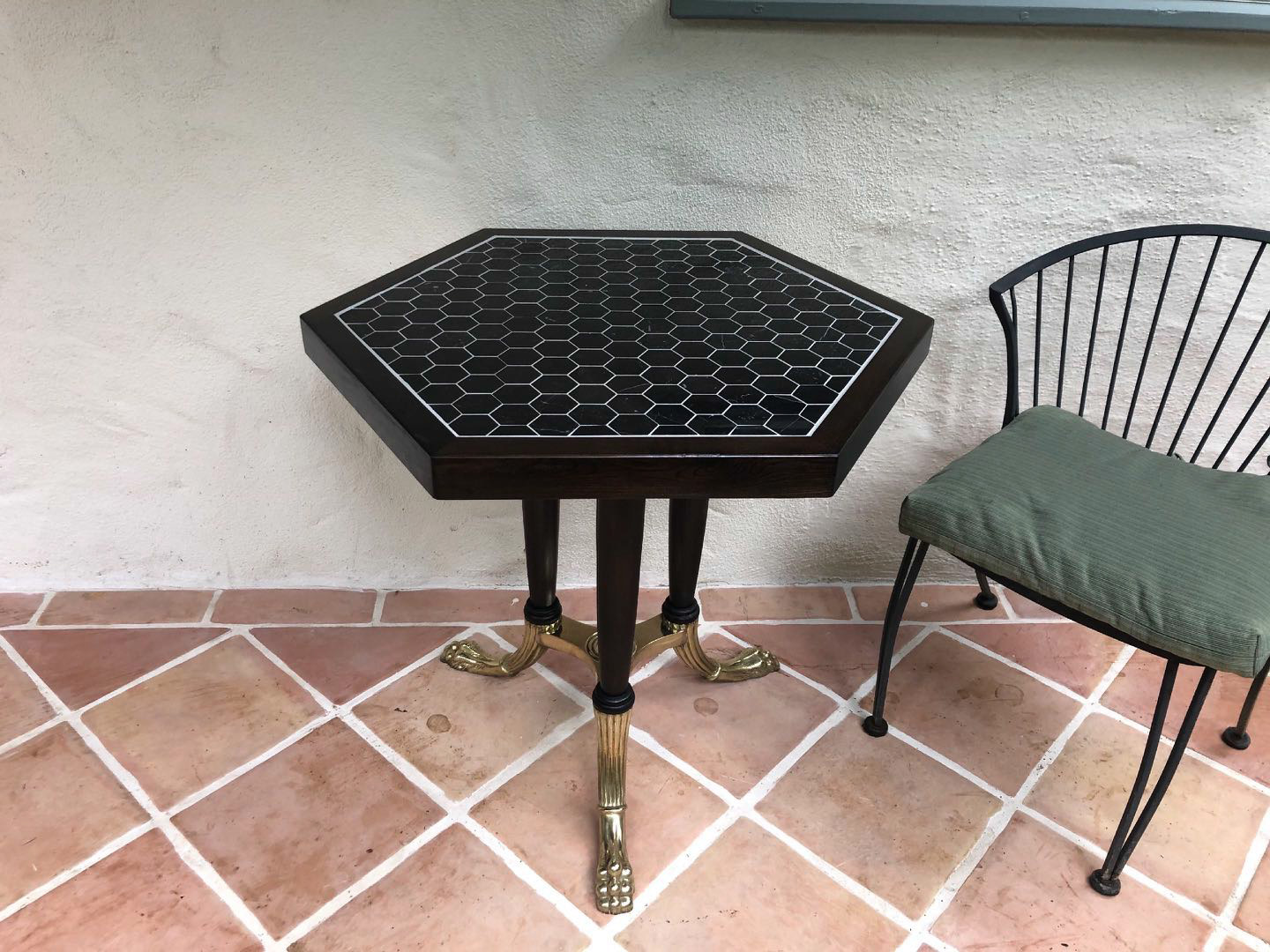
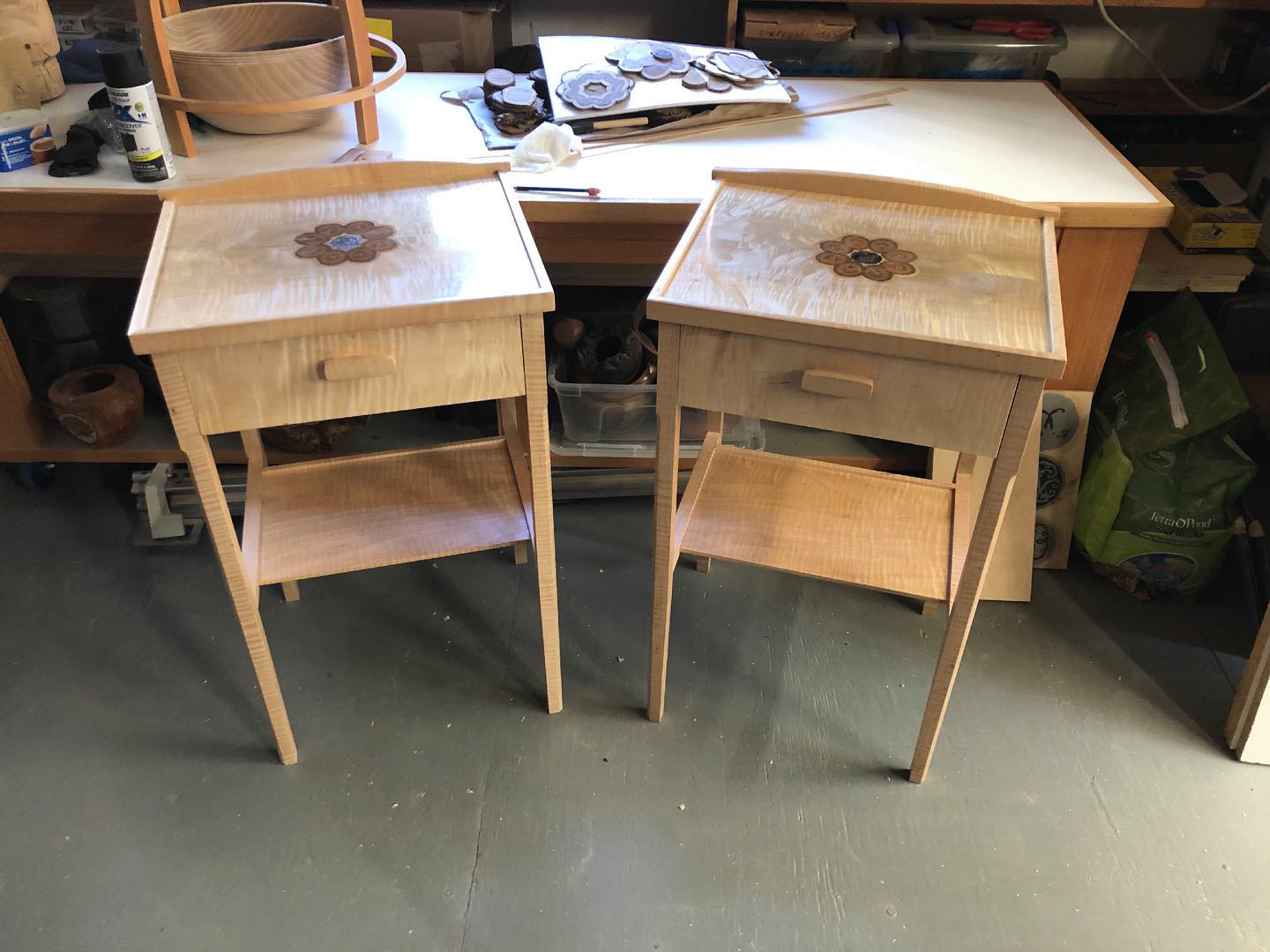
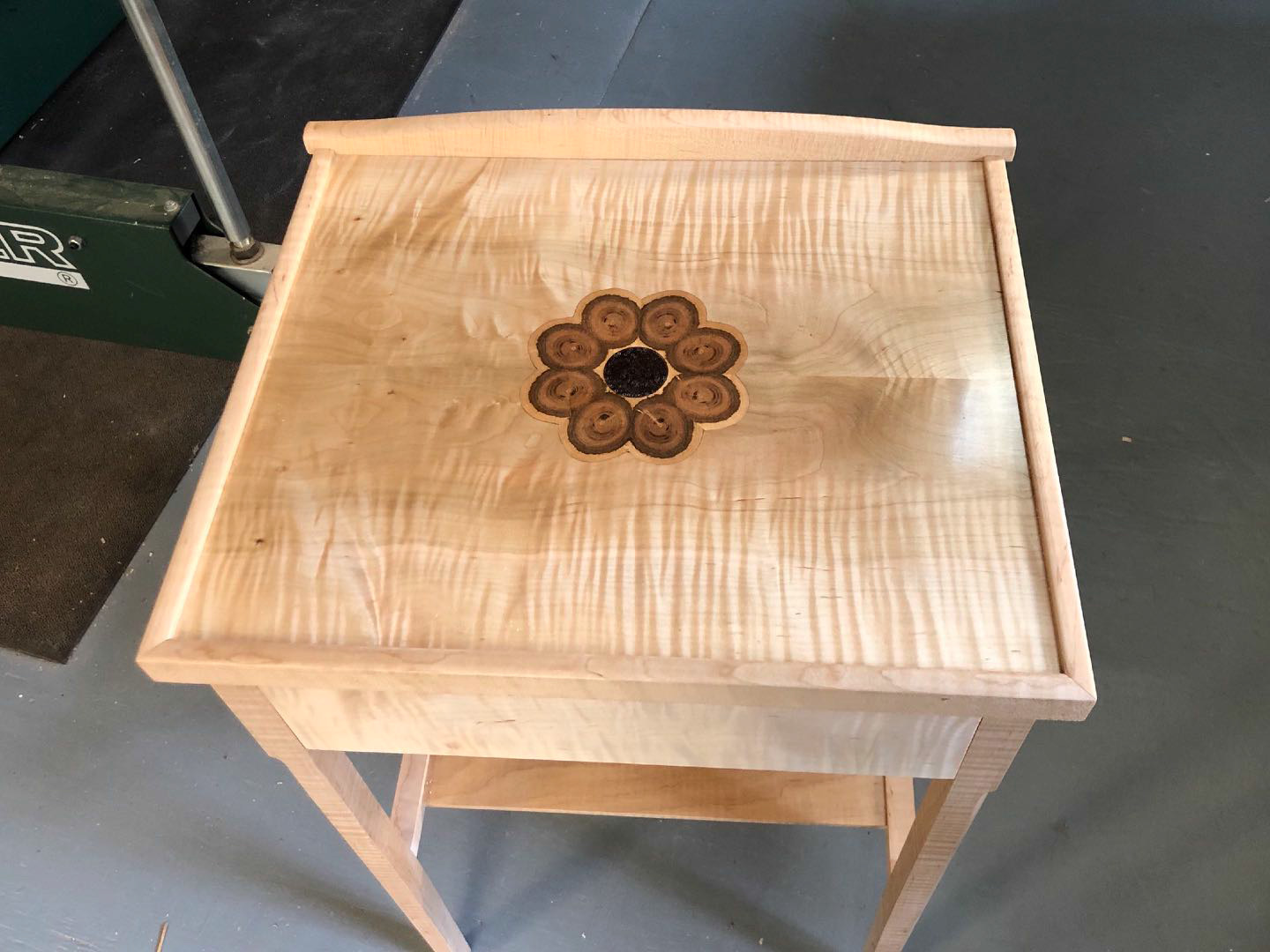
Tom showed a commissioned hexagonal side table
he made for a customer who provided him with semi-antique brass feet for it. The top is Hardie board with
hexagonal tiles inset. The edges are joined with biscuits.
He used a lathe with a self-centering auger bit to drill holes through the length of the legs to attach
the brass feet.
He also showed 2 maple end tables with veneer marquetry on top made from crossections of apricot tree branch.
The pieces are finished with shellac
except for polyurethane on top.
Bill Henzel
